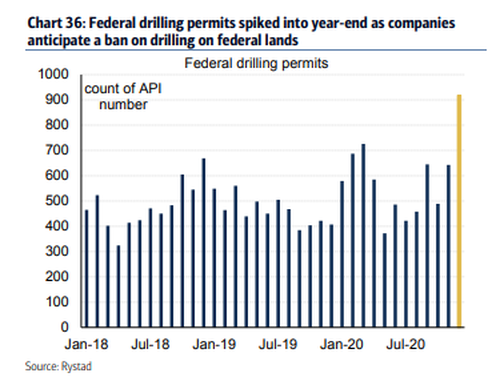Biden To Halt Oil, Gas Leasing On Federal Land
As previously reported, and as was just confirmed by the WSJ, President Biden on Wednesday will announce that he is halting all new oil and gas leasing on federal territory, “setting up a confrontation with the oil industry over the future of U.S. energy.” And since this effectively will suspend all fracking on federal lands (albeit once the extension period expires), this means that contrary to his representations, Biden is in fact banning fracking despite his Aug 31, 2020 proclamation that “I am not banning fracking. Let me say that again. I am not banning fracking, no matter how many times Donald Trump lies about me.”
As the WSJ reports, the Biden administration has drafted an order to impose the moratorium while it conducts a review of the federal oil and gas leasing program, in what is potentially a first step toward his campaign pledge to end future leases. The order is expected to be included in a package of measures across government aimed at reducing greenhouse gas emissions and boosting land conservation, which is just another conduit to legitimize trillions in taxpayer spending under the guise of “fixing the environment”, aka the oldest grift in the book, yet one which liberals and virtue-signalers fall for every single time.
In addition to the moratorium on oil and gas leasing, Biden is expected to set a goal of protecting 30% of federal land and water by 2030, the WSJ sources said. The president is also planning to re-establish a White House council of science advisers that was established during the Obama administration.
And since this was leaked well in advance, for those who missed it last week, we published a report from Goldman analyzing the consequences of the biden frack ban. We republish it again below:
Biden’s Federal Land Lease Ban To Send Oil Prices Higher: Goldman
Oil stocks tumbled following yesterday’s one-two punch of Biden energy news, when first we learned that the Interior Department enacted a 60-day moratorium on issuing oil and gas leases that affects all federal lands, minerals, and waters, which was followed by news that Biden was set to fully suspend the sale of oil and gas leases on federal land, which accounts for about a tenth of U.S. supplies.
Yet while E&P companies sold off sharply on the news, one can argue that the decision wasn’t exactly a surprise for the drillers themselves, because as the following chart from BofA shows, federal drilling permits spiked into year-end as companies clearly anticipated a ban on drilling on federal lands.
But it’s not just speculation about what impact on drillers – and especially frackers will be – Biden’s intervention will have: an just as important question is what to expect on the price of oil as a result.
Well, overnight, Goldman’s commodity team said that a lack of urgency from the US government to lift Iranian sanctions and a push for larger fiscal spending support the constructive view on oil and gas prices; at the same time it estimated that a 2 trillion stimulus over 2021-2022 would increase US demand by 200k bpd and stated that delays in a full return of Iran production would support the bullish oil outlook. Goldman’s summary, which could say is obvious: “policies to support energy demand but restrict hydrocarbon production (or increase costs of drilling and financing) will prove inflationary in coming years given the still negligible share of transportation demand coming from EVs (and renewables).“
In short, just what Putin and the Crown Prince ordered.
Below we excerpt from Goldman’s note:
Initial orders by the Biden administration include restrictions on North American hydrocarbon leasing, drilling and pipelines. In turn, initial comments suggest no urgency in lifting sanctions with Iran. Combined with a push for greater fiscal spending – and hence higher energy demand – these initial actions reinforce our constructive view on oil and gas prices. As we have argued, policies to support energy demand but restrict hydrocarbon production (or increase costs of drilling and financing) will prove inflationary in coming years given the still negligible share of transportation demand coming from EVs (and renewables).
- The Interior Department imposed on Wednesday a 60-day moratorium on oil and gas leases and drilling permits on federal lands, minerals, and waters. This order is temporary and has no impact on near-term activity as producers had aggressively accumulated federal drilling permits. While temporary, this order nonetheless suggests that the new administration views its pledge to halt leasing on federal lands as a priority of its climate plan, with such a broader moratorium on federal leasing potentially scheduled for next week according to Bloomberg. As we argued ahead of the election, such actions point to both higher production and financing costs for shale producers in coming years as well as lower recoverable resources. The additional orders to impose a moratorium on leasing activity in Alaska’s Arctic National Wildlife Refuge and to revoke Keystone XL’s border permit point to a similar regulatory shift.
- On their own, these actions do not point to a faster tightening of the oil market. in 2021-22, as a ban on permitting would still leave a window of up to two years to drill from elevated outstanding permits. In fact, this would likely shift drilling activity away from private to federal land (for example from the Midland to the Delaware basin) for a couple years to minimize the loss of recoverable resources. While producers are focused on shareholder returns over production growth,investors may support more aggressive drilling to secure future cash flows, potentially creating a modest headwind to sharply higher oil prices in the next few years. The administration’s focus on fiscal spending and recent foreign policy comments are, however, likely to help tighten the oil market in 2021-22.
- The release of President Biden’s COVID-relief plan has led our economists to increase their assumption for additional fiscal measures from $750bn to $1.1tn. Larger boosts to disposable income and government spending will make this recovery energy intensive long before it hurts oil demand, in our view, especially as they come alongside those in China and the EU. On our estimates, a $2 trillion stimulus over 2021-22 would for example boost US demand by c. 200 kb/d. Such spending would further contribute to a weakening dollar which itself lends support to oil prices. A faster vaccination roll-out would in turn accelerate the rebound in jet fuel consumption, which still accounts for more than half of the remaining lost oil demand.
- Finally, the new administration’s focus on reaching bi-partisan policy support suggest a lessened incentive to quickly revisit the divisive Iran nuclear deal. While the US president has significant freedom to re-enter the JCPOA agreement (see Appendix),the confirmation hearing for the US Secretary of State and Treasury Secretary focused on the need for consultation with Congress and US allies, on Iran being non-compliant and on the goal of reaching a stronger and longer new deal. We view such statements as consistent with our assumption that the increase in Iran exports will remain moderate in 2021 (we assume 0.5 mb/d in 2H21) with in fact risks that our assumed full recovery in Iran production in 2Q22 proves optimistic. Delays in a full return of Iran production would reinforce our bullish oil outlook since we already forecast a tight 2022 crude market with low OPEC spare capacity.
- Stronger demand and a slower ramp-up in Iran production would create a larger call non shale production, which will face higher regulatory costs, leading to further increases in long-dated oil prices. The oil market experienced such an outcome in 2018, when the loss of Iran production and strong economic growth pushed oil prices sharply higher. As we argued at the time, the rally to $80/bbl Brent prices was necessary to bring high-cost Bakken barrels to the global market by rail. Notably, the potential halt to Dakota Access Pipeline flows could recreate such conditions incoming years (the pipeline may need a new Environmental Impact Study from the Army Corps of Engineers, which is led by a presidential appointee which could stay its operations).
Tyler Durden
Tue, 01/26/2021 – 10:55
via ZeroHedge News https://ift.tt/2KOkihm Tyler Durden

